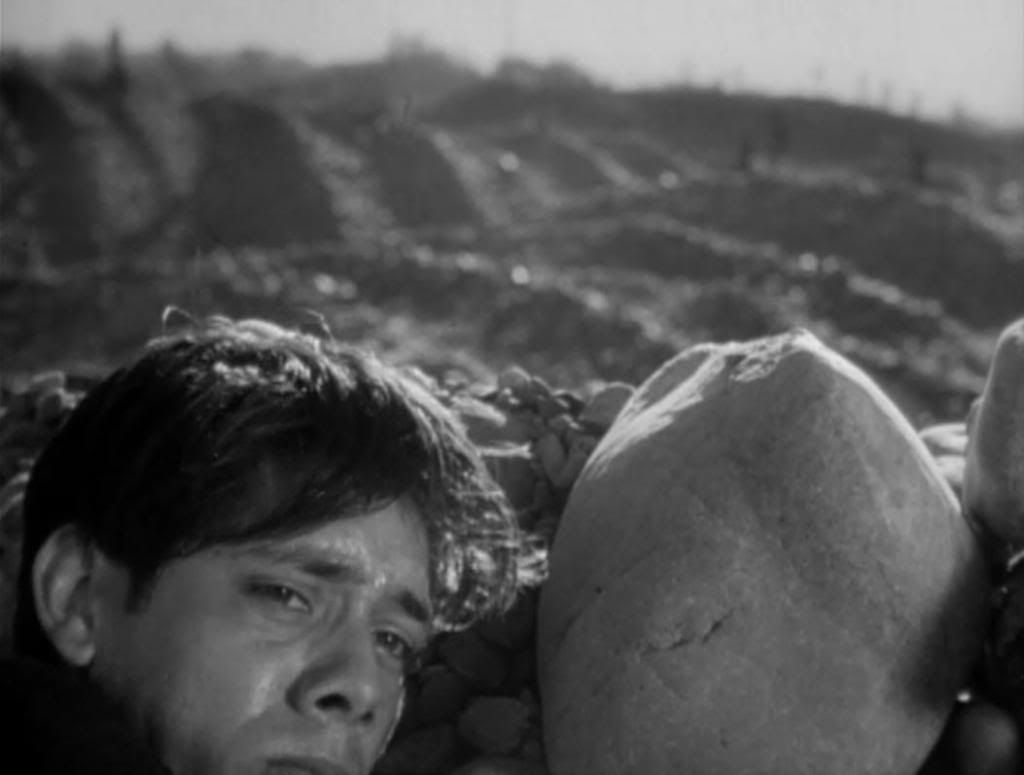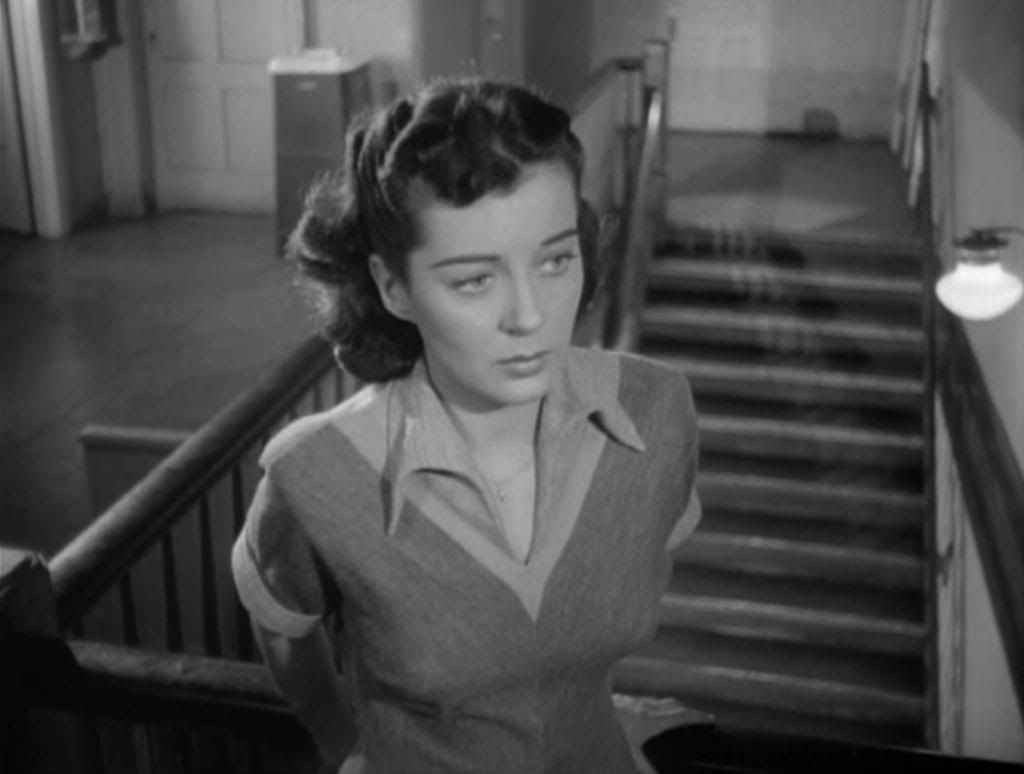
Joseph Losey's second film, The Lawless, is an inelegant liberal polemic about racism in a small town divided between a middle class white community and a poor, ramshackle neighborhood of Mexican-American fruit pickers who work on the local farms. Tensions are high between the young white kids and the Latinos, and they explode at a dance in the Mexican neighborhood when a few white guys crash the party — they hate the Mexicans but aren't above hitting on their women, joking that "those tomato-pickers have some pretty tomatoes." In the ensuing riot, the young Mexican Paul (Lalo Rios), scared of what will happen to him, goes on the run, stealing a car and, through a series of increasingly unlikely mishaps, making himself look more and more guilty, like a guy on a crime spree.
It's an obvious message movie about the eagerness of white America to railroad a poor young immigrant who they're only too willing to believe is an incarnation of malice and violence. Tied up in this drama is the newspaperman Larry Wilder (Macdonald Carey, coming off as a budget Jimmy Stewart), who had once been a crusader for controversial causes and big stories, but had now abandoned that for the quiet small town life he thought he wanted. He struggles with his conscience, trying to stay out of it, as he watches the racist passions of his town inflamed by unscrupulous reporters, thugs and bullies, and hatemongers. The film's script (by Daniel Mainwaring, adapting his own novel) is on-the-nose and obvious, hammering its points in with a complete lack of subtlety. The performances are also, for the most part, flat and amateurish, contributing to the sense of a clunky drama that's got its heart in the right place but falters in the execution. Only Gail Russell really shines as the young Mexican journalist Sunny Garcia, who serves as the sweet, wide-eyed, sensual voice of conscience gently nudging the jaded Wilder back towards engagement and activism.
Still, it's an effective polemic, and at times also a genuinely interesting movie. Losey forgoes music for long stretches, letting much of the film play out in ascetic silence, a sure sign of a low budget, but he uses this spartan aesthetic very effectively. The scene where the fugitive Paul is tracked to a riverside farm by the police is stunning and tense, as the increasingly frenzied Paul stumbles and runs, growing desperate, while lines of deputies advance steadily in pursuit. The terrain is rocky, covered in gravel, and the soundtrack contains only the clinking sounds of footsteps kicking the pebbles around. The camera tracks across the open field, taking in the bleak, wasted landscape of rocks and dirt as the men with shotguns spread out on their search. Losey's compositions are simple but striking, like an unbalanced closeup of Paul, his face shunted to the bottom of the frame beneath a rock ledge, while the focus is wracked from his terrified face in the foreground to the pursuers closing in on him and then back again.
Later, after his capture, as Wilder goes to see if he can convince the police to let Paul's parents see the boy, Losey remains with the parents, waiting on a bench. Everything remains silent, and Losey's camera simply sits still and watches, until Paul's father, without exaggeration or melodrama, lowers his head into his hands, overcome by the fear and emotion of this moment. When Wilder comes out and says that they can see Paul, Losey's camera remains out in the hall, watching from a distance, through the frame of a doorway, as Paul embraces his parents, leaving some respectful space for this intimate moment. This scene is followed by a confrontation between Wilder and Sunny, as he says he's bowing out and she accepts it, saying she understands while her face subtly conveys her disappointment. As he walks away down the staircase, Losey shoots from behind Sunny, watching him from the railing above, until he disappears from view; the angle of the shot places the two figures briefly side by side even though they're separated by the stairs, moving apart. The quiet and simplicity of these shots only makes them more affecting, unshowy but powerfully staged.

In other scenes — incidental moments, really — Losey is charmingly attuned to the low-key sensual pleasures of small town life, the things that make places like this so appealing when they're not self-destructing in orgies of racist violence. In one scene, Wilder and Sunny walk down an empty suburban street at night, and pass an old man burning autumn leaves by the curb. They stop briefly to watch, with Wilder cheerfully inhaling the smell and relishing it, then stroll on, seriously discussing the loss of Wilder's journalistic drive. But as they walk and talk, the fire lingers in the background, glimpsed in a reflection in the windows of the shops along the street, its smoke drifting into the frame over the heads of the two journalists.
There's also a surprising sensuality to a shot of Paul walking into his backyard, the camera following him, looking out past the clothesline to the freight train running past on the nearby tracks, then following him back to the crude shower hidden behind some scrap wooden boards by the house. Losey then cuts to a silhouette of a young man seen through the frosted glass of his shower, while a woman offscreen tells him to fill the ice bucket. It's a pointedly ironic cut, juxtaposing the poverty of the Mexican neighborhood, where what modern conveniences they have are jerry-rigged, against the wealth and luxury of the white neighborhood, which might otherwise have been taken for granted. The house in the white neighborhood is utterly ordinary, the kind of basic suburban home that might appear in countless other Hollywood movies without anyone thinking twice; Losey's class conscious juxtaposition of this everyday luxury against the poverty of those on the other side of town is a radical gesture for its time, as is the choice to tell such a racially charged story in the first place.
These racial themes explode most wildly in the scene where Paul supposedly assaults a young white girl, but in fact simply startles her by his mere presence — and presumably his race — causing her to turn around and start to run so blindly that she slams her head off a wooden beam. It's a darkly comical and jarring slapstick bit, delivering a sad joke about race and sex, and about the unsettling potency of stories about dark-skinned men assaulting white women. At the film's tense climax, all these prejudices finally erupt into exactly the lynch mob that seemed to have been simmering into formation all along. The destructive finale is then tempered by, refreshingly, just a hint of hope, a suggestion that the willingness to speak out against injustice is the first step on what's sure to be a long and difficult process of change. As an early effort from Losey, The Lawless is rough and sometimes clumsy (as in a fight scene where everyone is very obviously not landing any punches) and most of its cast is undistinguished. It wears its B-movie production values on its sleeve, alongside its bleeding-heart politics, but it's an interesting little film that already suggets the director's political interests and his keen photographic eye.
In this instance "obviousness" is strength of character.
ReplyDeleteFilms like this are why HUAC went after him.
Ah, you've penned a review here Ed of one of the very few Losey films I have not seen. With no legitimate DVD release, and no burning desire to invest in a bootie, I never got around to this. But I surely will soon enough. It's understandable why the performances would come off as amateurish and flat considering where the movie falls in Losey's filmmography, but it's far more important to focus in on the mor eimportant sociological and political messages you attest to. When I first started reading this I immediately thought of Anthony Mann's BORDER INCIDENT, but your subsequent analysis can only really support the similarity in the way Losey and Mann 'frame' their films. It's clear enough that THE LAWLESS anticipates the artistry that will come with experience and maturity a few films later.
ReplyDeleteAs always an exceptional essay in the service of a film with too little discussion.
David, Losey's convictions are definitely admirable, and this film is very good evidence of his political interests.
ReplyDeleteSam, it's understandably not one to rush out and see, but it's still enjoyable and interesting, especially to fans of Losey. But he really started to get great with a few of his 1951 movies, especially The Prowler and M.
« but he uses this spartan aesthetic very effectively »
ReplyDeleteIndeed. I haven't seen this film for a decade but I still remember the final chase . The dust, the rocks, the climbing, as if the whole world had turned against one man. There was something tragic - hence indeed something greek - about it.
Yes, that chase sequence is really something. It reminds me, in its spartan, dusty aesthetic, of the similarly great end of The Prowler from a year later.
ReplyDeleteLosey's directorial skill became apparent rahter quickly. After this as you point out came The Prowler (a cleaver low-rent Double Indemnity variation) and then his brilliant and unaccountably overlooked remake of M. He finishes it all off with The Big Night -- made while he was packign his bags for the UK.
ReplyDeleteThe mind boggles of what he might have made of High Noon had he beenable to stay.
I like his M a lot, too, David, I'll be posting about both that one and The Big Night in the next month or two. He had a great 1951, made even more remarkable by the fact that he must've known HUAC was closing in and he'd soon be out of there.
ReplyDeleteJust to let Sam and others know, Olive Films recently acquired the rights to this one, and while there's not a release date set yet we should hopefully be looking at a very nice (all their releases have been) edition coming at some point on at least DVD.
ReplyDeleteI think it's a pretty brilliant film. The more I dig into Losey's Hollywood stuff, the more I become convinced that it was his richest creative period.
That's great news, Drew! Hopefully that'll bring some attention to this overlooked but very worthy early Losey.
ReplyDelete